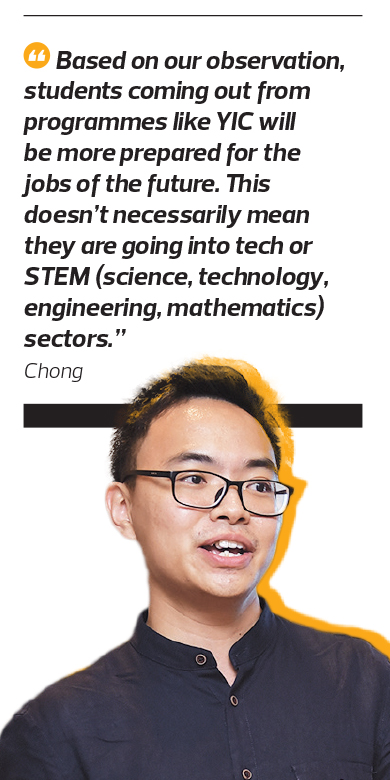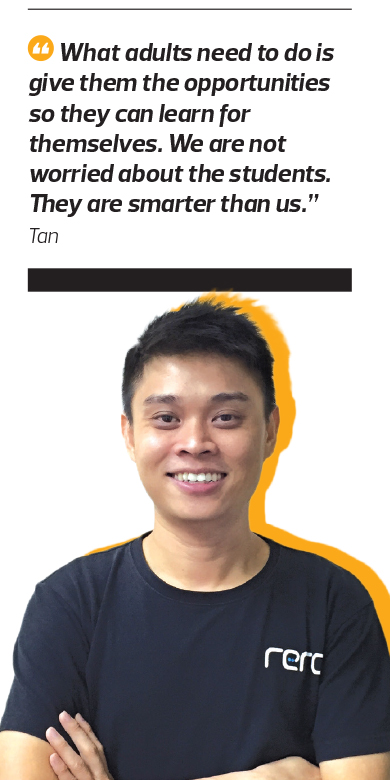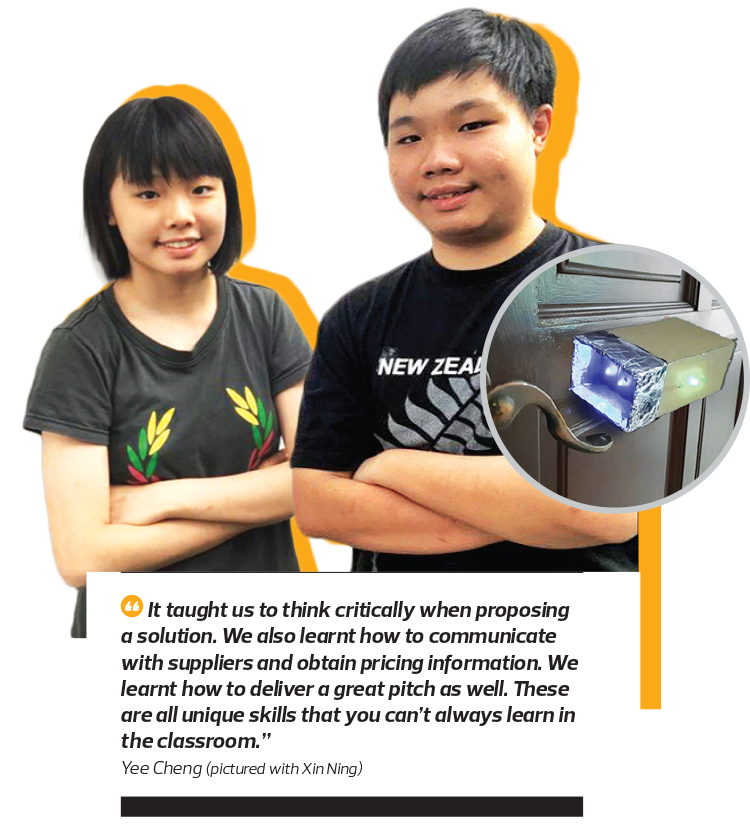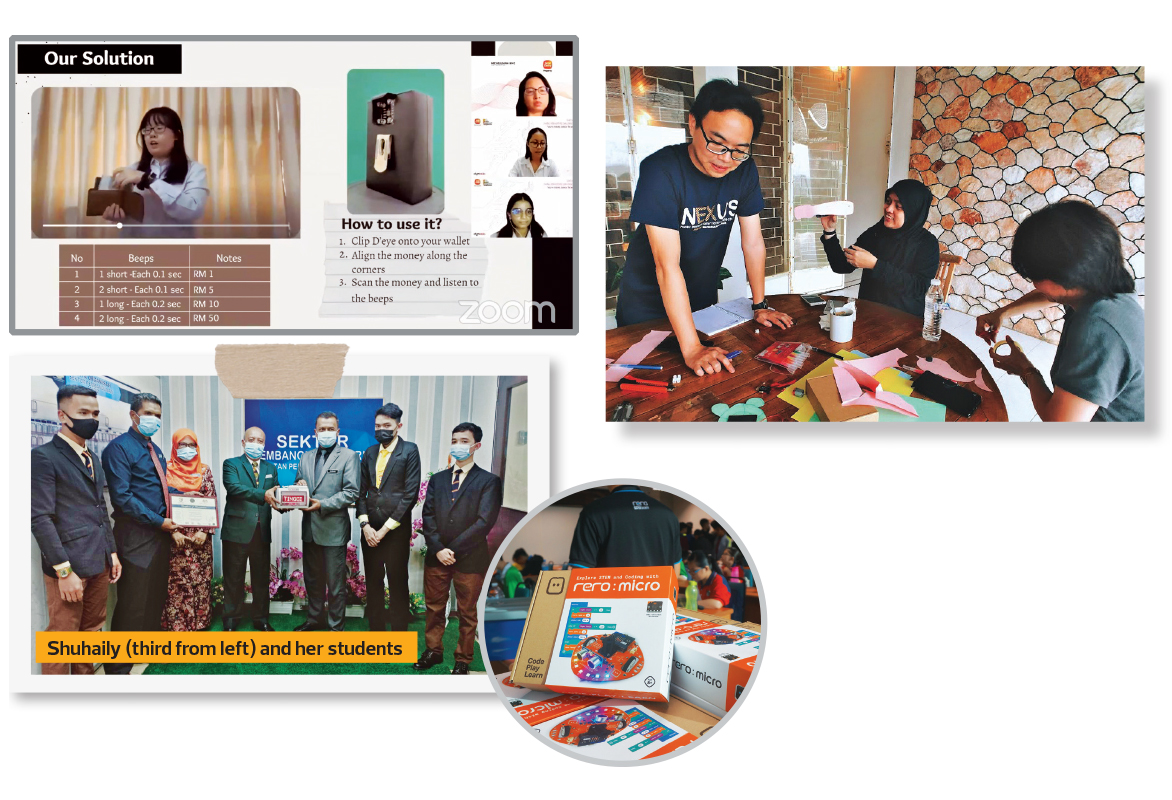
This article first appeared in Digital Edge, The Edge Malaysia Weekly on January 24, 2022 - January 30, 2022
When the rest of their classmates were stuck at home doing online classes, Muhamad Lokman B Rosdi and two of his friends from Sekolah Menengah Kebangsaan Mulong in Kelantan were busy learning how to use Arduino, an open-source electronic prototyping platform, coding and coming up with a tech solution to solve problems that their teachers were facing.
Lokman, Muhammad Atiff Amdzar and Muhamad Faiszuddin were participating in the Young Innovators Challenge (YIC) and tasked with using open-source software to solve real-life problems. The YIC was organised by Chumbaka Sdn Bhd and supported by Yayasan Sime Darby and Malaysia Digital Economy Corporation (MDEC), among others.
“We wanted to join the competition because we would get to learn coding and create something to make life easier for people. We think the programme is very meaningful and interesting,” says Lokman.
The three 17-year-olds set up interview sessions with teachers, sat through webinars to learn coding and Arduino, brainstormed using design thinking principles and received guidance from their teachers to build a prototype. They eventually settled on building a digital height measuring machine after conducting interview sessions with several teachers.
“We saw that teachers faced difficulties when performing physical tests for students. They were taking a long time to do height measurement for students manually, so we thought we could make it easier and faster for them,” says Lokman.
The machine has to be placed 200cm above the ground and against a wall. It uses ultrasonic sensors to measure the distance between the student’s head and the machine. From there, it will calculate the height of the student and display it on the screen.
“The hardest part about this was learning how to code. We had to get a lot of guidance from our computer science teachers,” Lokman says.
After a successful video pitch to the judges, the team won a grant from YIC to produce 30 of these machines to distribute to neighbouring schools and clinics.
“If we have a chance, we will join competitions like this again because innovation is very interesting in this modern era. Now that we have more knowledge about coding, we feel interested in taking a computer science course in university,” says Lokman.
Their teacher, Shuhaily Yusoff, has been leading teams to join YIC since 2018. Back then, the school’s team created a grass-cutting machine controlled by smartphones and won the gold medal at the state level. She finds this programme useful, and not just because it teaches students technical skills such as coding.
“We are a school on the outskirts of town. When students are involved in programmes like this, we see that they are exposed to the outside world and interact with people. Before this, they were shy. But now, they can express their opinions. They have self-confidence,” says Shuhaily, who teaches computer science in the secondary school.
This sentiment was echoed by other participants and teachers involved in the YIC who were interviewed by Digital Edge. The students appreciated the opportunity to learn coding and apply these skills to solve problems for people around them. The teachers saw students, regardless of their academic performance, learn how to communicate and empathise with people.
Of course, YIC isn’t the only such programme around. There are increasingly more tech and innovation competitions being held, and Malaysian youth are making a name for themselves globally by creating innovative solutions for real-world problems.
For instance, three Malaysian students from the Asia Pacific University of Technology & Innovation won a chance to compete in the international James Dyson Award last year with their invention: a sustainable seawater desalination pod.
This could be seen as good news for the country as it heads into the digital economy, where automation and fast-evolving technologies could take away old jobs and require people to pick up new skills quickly. Demand is high for those with skills such as coding or programming.
Already, many employers complain that the education system is not churning out people that have the relevant technical skills or necessary soft skills, like communication, creativity and critical thinking. Some blame this on the rote learning system in schools and others, on outdated course content in universities.
Addressing this problem now, however, is crucial. The World Economic Forum’s (WEF) Future of Jobs Report in 2020 found that critical thinking and problem-solving skills are the skills employers believe will become more prominent in the next five years. Next are skills in self-management, like active learning, resilience, stress tolerance and flexibility.
This is against the backdrop of a sharp shift in job requirements. In fact, 42% of core skills required to perform existing jobs are expected to change in the next two years and more than one billion people will have to be reskilled by 2030. As technological development picks up pace, individuals are expected to be flexible enough to learn quickly and adapt to changes.
“Based on our observation, students coming out from here (programmes like YIC) will be more prepared for the jobs of the future. This doesn’t necessarily mean they are going into tech or STEM (science, technology, engineering, mathematics) sectors. A lot of them are using technology to solve social or environmental problems. For instance, if they want to be farmers, they will be good ones who use technology,” says Chong Zhi Xiong, chief learning officer at Chumbaka.
As suggested by WEF, this ability to solve problems will be highly valued in the future. And these young people have the natural inclination to do so when given the chance, observes Chong. This also underscores the fact that these competitions are not just about learning the technology.
“What we kept noticing was that at the end of the competition, students always reflect that they learnt something non-tech related. They talk about communication and how to work with each other, as well as learning creativity and critical thinking. The kids realise that it is not all technology,” says Chong.
The best solutions, after all, are the ones that use simple technology that actually solves the problem. Design thinking skills, which emphasise empathy with the target audience to create relevant and effective solutions, are helpful in achieving that goal.
Seventeen-year-old Ng Yee Cheng definitely saw that as a valuable lesson. He joined YIC with his sister, Ng Xin Ning, and created a portable ultraviolet-C (UVC) light to sanitise door handles in public places. This was inspired by a problem their father faced in his workplace.
“It taught us to think critically when proposing a solution. We also learnt how to communicate with suppliers and obtain pricing information. We learnt how to deliver a great pitch as well. These are all unique skills that you can’t always learn in the classroom,” says Yee Cheng.
“The design thinking skills I learnt will change how I approach different scenarios in the future, and it has encouraged me to stay curious. I hope to be a software engineer in the future, so this curiosity is important. The experience also taught me to be more adaptable to change and accept criticism.”
The siblings received a grant from YIC to produce five units of the sanitiser for communities such as orphanages, old folks’ homes and commercial buildings.
“As a recent graduate, I wouldn’t say I’m fully prepared to adapt to this automation-based economy, but I’m just really glad that programmes like this provide the opportunity for us to develop our prototype into a real solution. I think it makes me more adaptable to the economy of the future,” says Yee Cheng.
Can such skills be taught in every school?
To truly inculcate these new skills — be they technical or soft skills — in students, it could make sense to integrate elements from competitions such as YIC into the national curriculum so that all students can benefit.
This is already being done on some level in schools. MDEC and the Ministry of Education’s #mydigitalmaker movement, for instance, is a step in the right direction, observes Chong. According to MDEC’s website, there are now 122 digital maker hubs in schools and communities. Of course, these concepts cannot be only taught theoretically.
Another important point is to ensure that these resources are also available to rural schools. YIC achieved this by attracting almost 40% of rural school students to join the competition, with the highest participation rate from schools in Sabah and Sarawak, according to Chong.
The impact of such exposure can be significant, even for teachers. Anuthra Sirisena, founder of Tenom Innovation Centre (TIC) in Sabah, saw this first-hand when she trained students to join YIC in 2017. Although she was a chemistry teacher, she joined the teacher training sessions to learn about Arduino and coding.
“The workshop was a turning point for me. I saw the spark in my students. Usually, those who volunteer to join these competitions are the academically bright students, but I was surprised to see the other students involved too. I began to think that maybe robotics is how I can [create a] bridge with the students,” says Anuthra.
In 2018, she started the TIC, which is a maker space that allows students to apply digital making skills. “We started TIC because we are in a rural area and we always have to wait for someone to come to us with a programme or project. But when are they going to be here?” she says.
“The students need to expand their skills beyond what is taught in school. We no longer live in a society where you can only be successful if you leave your kampung. I think the kids can leverage what they have in the community and build on that. The only way we can do that is by teaching them robotics and digital skills.”
The TIC organises after-school programmes and an annual maker fair for students. Through grants, it has managed to reach more than 18 schools in Tenom so far. The students mentor each other and give suggestions on how to run the programme, says Anuthra. This builds their self-confidence.
“In rural areas, they tend to have limited ideas about their careers. But I think my students are already making different decisions from their parents. I have students who are taking up engineering courses or scholarships to go out of the state because of their involvement in TIC,” she says.
Save by subscribing to us for your print and/or digital copy.
P/S: The Edge is also available on Apple's App Store and Android's Google Play.






